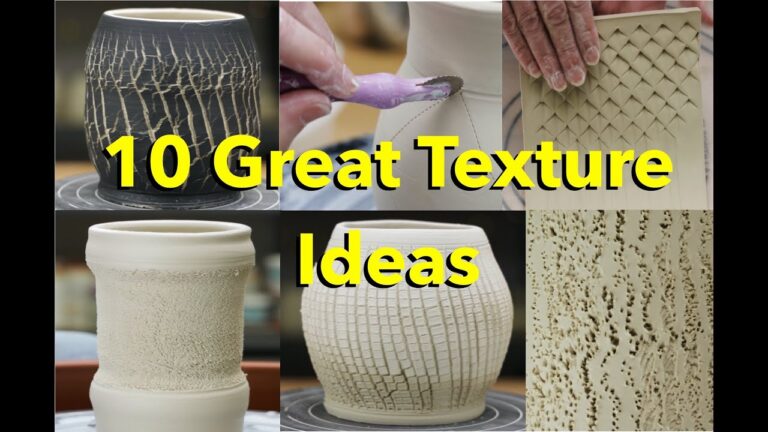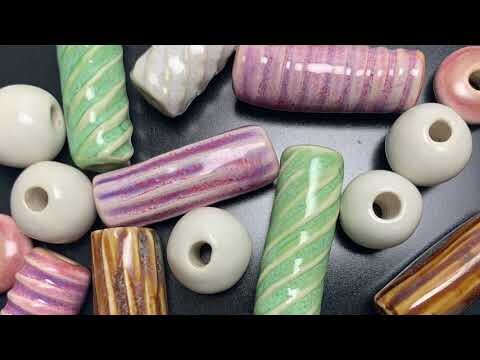Texturing techniques in ceramics add depth and visual interest to pottery pieces, elevating them from ordinary to extraordinary. From carving and stamping to slip trailing and sgraffito, these techniques allow artists to create intricate patterns and unique designs on their creations. This article explores the various texturing techniques in ceramics and how they can be used to enhance the beauty and craftsmanship of pottery.
How can ceramics be textured?
To texture ceramics, I begin by manipulating the surface of the clay at an early wet stage, creating multiple layers to reveal depth and contrast with raised textural elements. I use the clay provided by the existing form and simply displace it to achieve the desired texture. This method allows for a dynamic and visually striking result in the finished piece.
What is the purpose of texture tools in ceramics?
Texture tools in ceramics are essential for adding visual interest and depth to clay pieces. By applying these tools to the clay while the wheel is turning, unique patterns and designs can be created. These tools are particularly effective when the walls of the pot are thicker and more vertical, allowing for the textures to stand out.
Some common texture tools include ribbed tools, loop tools, and wire tools, each providing a different effect on the clay surface. Ribbed tools can create linear patterns, while loop tools can create more organic and flowing textures. Wire tools are great for adding finer details and intricate designs to the clay. By using a combination of these tools, potters can truly enhance the aesthetic appeal of their pieces.
Once the desired texture is achieved, potters can further manipulate the shape of the pot to create unique and non-linear forms. This versatility allows for endless possibilities in terms of design and creativity. Texture tools play a crucial role in the ceramic process, allowing artists to add their own personal touch and style to their creations.
What techniques are used in pottery making?
Pottery making utilizes various ceramic techniques, with wheel-throwing being one of the most popular. This method involves shaping the clay on a spinning wheel, allowing for precise and symmetrical forms. Slipcasting, on the other hand, involves pouring liquid clay into a mold, resulting in intricate and detailed designs. Finally, handbuilding is a technique that involves shaping the clay by hand, allowing for more creative and unique forms. Each technique is best suited for different types of clay, with wheel-throwing being ideal for stoneware and porcelain, slipcasting for earthenware, and handbuilding for any type of clay.
In addition to the ceramic techniques, the choice of glaze is crucial in pottery making. Satin glazes provide a smooth and soft finish, gloss glazes create a shiny and reflective surface, and matte glazes result in a non-reflective and textured look. The type of glaze chosen also depends on the type of vessel being created, with satin glazes being best for functional pieces, gloss glazes for decorative items, and matte glazes for adding a natural and earthy feel to the pottery. Understanding these techniques and glazes allows for the creation of stunning and unique ceramic pieces.
Overall, mastering the various ceramic techniques and understanding the different types of glazes opens up a world of creative possibilities in pottery making. Whether using wheel-throwing for precise forms, slipcasting for intricate designs, or handbuilding for unique shapes, each technique offers its own set of advantages. Coupled with the right choice of glaze, these techniques allow for the creation of beautiful and functional ceramic pieces that showcase the artist’s skill and vision.
Elevate Your Pottery with Advanced Texturing Methods
Are you looking to take your pottery to the next level? Elevate your creations with advanced texturing methods that will add depth and character to your pieces. By incorporating techniques such as sgraffito, carving, and stamping, you can create unique and visually striking designs that will set your pottery apart from the rest.
Sgraffito involves scratching through a layer of colored slip to reveal the clay underneath, creating intricate patterns and designs. Carving allows you to sculpt intricate details and textures into your pottery, adding a tactile element to your pieces. Stamping involves pressing various objects or tools into the clay to create patterns and textures, resulting in a visually interesting surface.
With these advanced texturing methods, you can take your pottery to new heights and showcase your creativity and skill. Experiment with different techniques and combinations to create one-of-a-kind pieces that will leave a lasting impression. Elevate your pottery with advanced texturing methods and watch as your creations become true works of art.
Unlocking the Secrets to Stunning Ceramic Surfaces
Unlocking the secrets to stunning ceramic surfaces requires a keen eye for detail and a creative touch. By experimenting with different glazes, textures, and firing techniques, artists can achieve truly unique and beautiful results. From vibrant colors to intricate patterns, the possibilities are endless when it comes to creating captivating ceramic surfaces that are sure to impress. With dedication and a willingness to explore new techniques, artists can unlock the true potential of their ceramic creations and create works of art that are truly breathtaking.
Transform Your Clay Creations with Pro Texturing Techniques
Transform your clay creations into stunning works of art with the help of professional texturing techniques. Elevate your designs to the next level by learning how to add depth, dimension, and visual interest to your projects. Whether you’re a beginner or an experienced artist, these techniques will take your clay creations from ordinary to extraordinary.
Discover the secrets of expert texturing and watch as your pieces come to life with intricate patterns, realistic textures, and unique finishes. With the right tools and guidance, you can unleash your creativity and bring your vision to fruition. From simple techniques like stamping and carving to more advanced methods such as sculpting and etching, there’s a whole world of possibilities waiting for you to explore.
Unleash your artistic potential and push the boundaries of what you thought was possible with clay. With these pro texturing techniques at your disposal, you can create one-of-a-kind pieces that reflect your individual style and creativity. Whether you’re making jewelry, home decor, or sculptures, these techniques will help you take your clay creations to new heights and stand out from the crowd.
Incorporating various texturing techniques in ceramics not only adds depth and visual interest to the finished piece but also allows for a unique and personalized touch. By experimenting with different methods such as carving, stamping, and slip trailing, artists can create one-of-a-kind pieces that showcase their creativity and skill. Whether aiming for a rustic, organic look or a more modern and geometric design, texturing techniques offer endless possibilities for artists to explore and push the boundaries of traditional ceramic art. By embracing these techniques, artists can truly elevate their work and captivate viewers with the intricate details and tactile appeal of textured ceramics.



